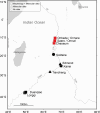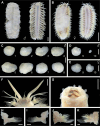Distribution extension of a vent scale worm Branchinotoglumabipapillata (Polychaeta, Polynoidae) in the Indian Ocean
- PMID: 39440028
- PMCID: PMC11494209
- DOI: 10.3897/zookeys.1215.129623
Distribution extension of a vent scale worm Branchinotoglumabipapillata (Polychaeta, Polynoidae) in the Indian Ocean
Abstract
Branchinotogluma Pettibone, 1985 is the most species-rich genus within the subfamily Lepidonotopodinae Pettibone, 1983, comprising 18 valid species from chemosynthesis-based ecosystems in the Pacific and Indian Oceans. Here, we report a new distributional record of Branchinotoglumabipapillata Zhou, Wang, Zhang & Wang, 2018, at the hydrothermal vent sites on the northern Central Indian Ridge (nCIR). This record represents the northernmost occurrence of B.bipapillata in the Indian Ocean. We conducted a comparative study of the nCIR population and other documented populations using distributional information, morphological traits, and genetic markers (two mitochondrial [COI, 16S rRNA] and one nuclear [18S rRNA] genes). While most morphological characters of B.bipapillata were consistent with those found in the Southwest Indian Ridge (SWIR), variations were noted in the segment with the last branchiae. Molecular data revealed that all populations of B.bipapillata form a single clade, indicating a wide distribution from the SWIR to nCIR, covering ~4,000 km across various ridges in the Indian Ocean. This study presents extensive distribution of a vent species with well-connected populations throughout the Indian Ocean, distinguishing it from many other vent species affected by the dispersal barrier in the Indian Ocean.
Keywords: 16S rRNA; 18S rRNA; CO1; deep-sea; hydrothermal vent; northern Central Indian Ridge; polynoids.
Won-Kyung Lee, Se-Joo Kim.
Conflict of interest statement
The authors have declared that no competing interests exist.
Figures




Similar articles
-
Branchinotogluma bipapillata n. sp., a new branchiate scale worm (Annelida: Polynoidae) from two hydrothermal fields on the Southwest Indian Ridge.Zootaxa. 2018 Sep 19;4482(3):527-540. doi: 10.11646/zootaxa.4482.3.5. Zootaxa. 2018. PMID: 30313812
-
Hungry scale worms: Phylogenetics of Peinaleopolynoe (Polynoidae, Annelida), with four new species.Zookeys. 2020 May 12;932:27-74. doi: 10.3897/zookeys.932.48532. eCollection 2020. Zookeys. 2020. PMID: 32476973 Free PMC article.
-
A New Branchipolynoe (Aphroditiformia: Polynoidae) Scale Worm from the Onnuri Deep-sea Hydrothermal Vent Field, Northern Central Indian Ridge.Zool Stud. 2022 May 30;61:e21. doi: 10.6620/ZS.2022.61-21. eCollection 2022. Zool Stud. 2022. PMID: 36330019 Free PMC article.
-
Phylogeny of hydrothermal vent Iphionidae, with the description of a new species (Aphroditiformia, Annelida).Zookeys. 2018 Aug 2;(779):89-107. doi: 10.3897/zookeys.779.24781. eCollection 2018. Zookeys. 2018. PMID: 30108430 Free PMC article.
-
Deep-sea ecosystems of the Indian Ocean >1000 m.Sci Total Environ. 2024 Dec 20;957:176794. doi: 10.1016/j.scitotenv.2024.176794. Epub 2024 Oct 18. Sci Total Environ. 2024. PMID: 39426531 Review.
References
-
- Chen C, Copley JT, Linse K, Rogers AD. (2015) Low connectivity between ‘scaly-foot gastropod’ (Mollusca: Peltospiridae) populations at hydrothermal vents on the Southwest Indian Ridge and the Central Indian Ridge. Organisms Diversity & Evolution 15: 663–670. 10.1007/s13127-015-0224-8 - DOI
-
- Edler D, Klein J, Antonelli A, Silvestro D. (2021) raxmlGUI 2.0: a graphical interface and toolkit for phylogenetic analyses using RAxML. Methods in Ecology and Evolution 12: 373–377. 10.1111/2041-210X.13512 - DOI
-
- Gamo T, Chiba H, Yamanaka T, Okudaira T, Hashimoto J, Tsuchida S, Ishibashi J-i, Kataoka S, Tsunogai U, Okamura K. (2001) Chemical characteristics of newly discovered black smoker fluids and associated hydrothermal plumes at the Rodriguez Triple Junction, Central Indian Ridge. Earth and Planetary Science Letters 193: 371–379. 10.1016/S0012-821X(01)00511-8 - DOI
-
- Han Y, Zhou Y, Chen C, Wang Y. (2023) Diversity and biogeography of scale worms in the subfamily Lepidonotopodinae (Annelida: Polynoidae) from Indian Ocean hydrothermal vents with descriptions of four new species. Zoological Journal of the Linnean Society 201: 290–304. 10.1093/zoolinnean/zlad140 - DOI
LinkOut - more resources
Full Text Sources
